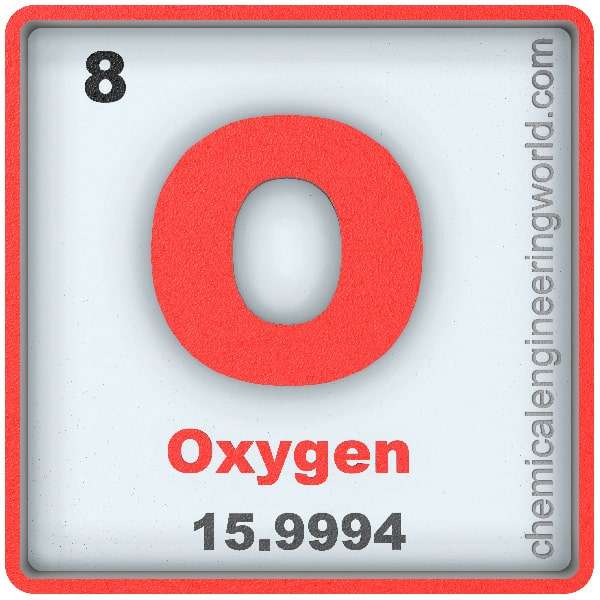Oxygen Element Properties and Information

Oxygen Element Properties and Information:
Oxygen is eight element on the periodic table. Elements are arranged in the periodic table on the basis of the atomic number. Atomic number is the number of protons in the nucleus of the atom. Oxygen has an atomic number of 8. It is located in the Group 16 and Period 2 of the periodic table of elements. It is denoted by O. The name is derived from the Greek words ‘Oxy’ and ‘Genes’ which means Acid Forming.
Joseph Priestly is credited with publishing the first account of oxygen in 1774. He collected the gas which came off by focusing sunlight on mercuric oxide. Cornelius Drebbel had shown in 1608 that heating potassium nitrate released some gas but he didn’t identify it as oxygen.
Oxygen is the third most abundant element in the universe after hydrogen and helium. It is the most abundant element on earth. The oxygen is one of the major constituent of air and makes up concentration of about 21% by volume. The earth’s crust consists of 49.2% of oxygen by mass. It is present in all different types of rocks on planet and the most common form in which it is available is silicon dioxide. Oxygen is virtually present in all the organic molecules in the living body and it makes up about 66.66% of human body.
Physical Characteristics:
- Oxygen is a colourless, odourless and tasteless gas which is very important to keep living beings alive.
- The atomic mass of oxygen is 15.999
- The melting point of oxygen is -219°C
- The boiling point of oxygen is -183°C
- The density of oxygen is 1.429 in S.I. units at 20°C
- Solid oxygen has six phases. Tetraoxygen was discovered in 2001 and it is a constituent in one of the phases.
- Subjecting solid oxygen to pressures as high as 96GPa results in a metallic phase and if this phase is simultaneously subjected to very low temperatures then it becomes a superconducting.
- Oxygen dissolves more readily in water than nitrogen and also oxygen dissolves more readily in fresh water than in sea water.
- Oxygen has three stable isotopes; oxygen-16, oxygen-17 and oxygen-18. Oxygen-16 is the most abundant making up to 99.762% of total oxygen.
Chemical Properties:
- Oxygen is a highly reactive non metallic element.
- Oxygen readily forms oxides with almost all other elements.
- Elemental oxygen is extremely reactive this it is not found anywhere on earth except that amount which forms due to photosynthesis action of cyanobacteria, plants and related living organisms.
Methods of Production:
- Distillation of Air: This is the most common method used for separation of nitrogen and oxygen. The air is first cooled in stages in order to decrease the temperature to -200°C. During the cooling process, the water vapour condenses first and it is removed using absorbents, the carbon dioxide then solidifies at -79°C and it is removed, then oxygen condenses at -183°C and nitrogen at -196°C. The liquid nitrogen and oxygen mixture is passed to a fractionating column. The temperature is relatively warmer at the bottom such that the oxygen stays in liquid form while passing through the column but nitrogen vaporises and it gets removed from the top of the column. The liquid oxygen flows out of the system from the bottom of the column.
- Molecular Sieves: Air is passed through a bed of zeolite molecular sieves which absorbs much of the nitrogen and produces a stream of high concentration oxygen. The concentration in the output stream is 90-93%.
- Electrolysis: Electrolysis of water is also used to produce oxygen but for this method DC electricity should be used using AC electricity results in hydrogen to oxygen ratio of 2:1 which is explosive.
Relevance in Chemical and Related Industries:
- Steel Industries: A major portion of about 55% of total commercially produced oxygen is used for smelting of iron ore into steel. During smelting process oxygen is passed through high pressure lance into molten iron inorder to remove sulfur and carbon impurities. The sulfur combines with oxygen and becomes sulphur dioxide and carbon combines with oxygen to become carbon dioxide. It is a highly exothermic reaction where the temperature reaches 1700°C.
- Chemical Industries: They use about 25% of the total commercially produced oxygen. Oxygen is used to make many compounds, some notable compounds are ethylene oxide, acrylic acid, diformyl-furane and benzylic acid.
Relevance in Other Industries:
- Medicine: Oxygen therapy is used to treat pneumonia, emphysema, congestive heart failure and any kind of disease that impairs body’s ability to take up oxygen.
- For Life Support: Oxygen is used as low pressure breathing gas in space suits. Scuba divers rely on artificially delivered oxygen. Submarines have continuous oxygen supply and aircrafts have oxygen supplement source.
Health Effects on Exposure:
- Toxicity: Although oxygen is extremely important for life but too much increase in concentration of oxygen causes oxygen toxicity which leads to convulsions and related problems. Breathing oxygen above 50% and normal or high pressure for prolonged period damages lungs.
Effects on Surroundings:
- Promotes Combustion: Presence of high concentration source of oxygen around a fuel source promotes combustion if a spark gets induced.
References:
































